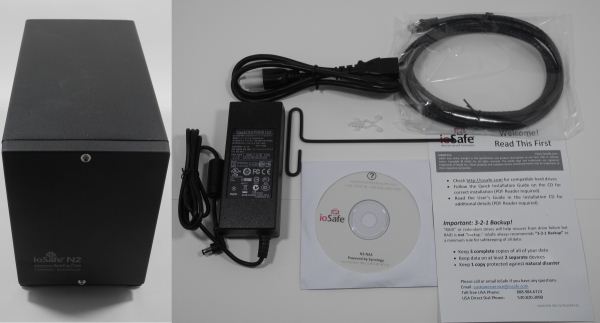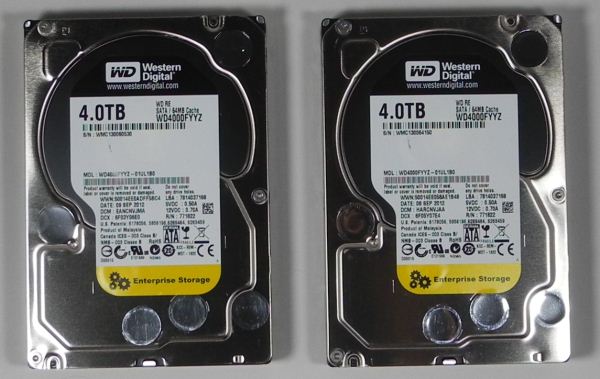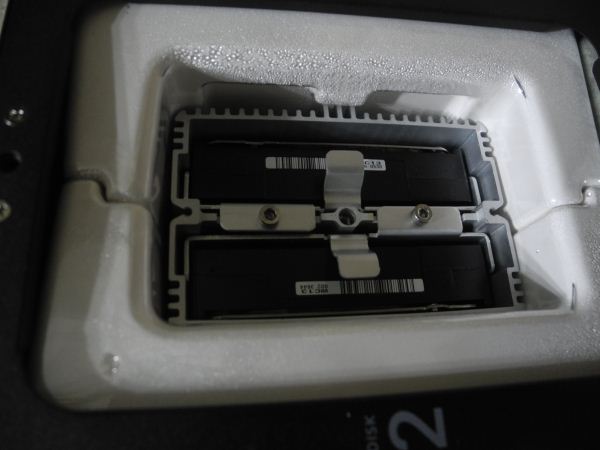ioSafe N2: A Disaster-Resistant Synology DS213
by Ganesh T S on March 4, 2013 12:00 PM ESTUnboxing and Hardware in Action
The striking aspect of the ioSafe N2 is, like the SoloPRO, its sheer weight. In addition to being fire and water-resistant, this makes it extremely unattractive as a target for theft during break-ins. There is a Kensington security slot, but the floor mount kit which was integrated in the SoloPRO is strangely made an optional accessory in this product. Unlike the SoloPRO, there is no curved front piece, but the industrial design is still excellent while making the internal disks user-accessible. All the external ports available in the DS213 are also available in the ioSafe N2. However, the locations of the ports have been modified to suit the new chassis.
The power switch / LED indicators, a USB 2.0 port and a SD card slot make up the bottom of the front face. The rear segment has two USB 3.0 ports, a 10/100/1000 Mbps RJ-45 port and a power adapter connector.
The Kensington slot also makes an appearance here. A ventilation fan takes up the remaining space on the rear panel. Along with the main unit, we also have a 72W DC power adapter, a 6 ft Cat 5 Ethernet cable, setup CD, a welcome guide and a specialized Allen wrench to use with the screws in the ioSafe N2.
One of the advances made by ioSafe with the N2 is the fact that the hard disks are user-accessible. This means that the end-user has visibility into the components which provide fire and water resistance to the disks. Upon removing the front face of the N2, we find the DataCast material on the rear side of the front panel as well as around the hard drive bays in the main chassis.
The hard drives are behind another layer of protection. This panel has a rubber gasket all along its perimeter to ensure that any water which makes it past the front panel doesn't get into the hard drive compartment.
Getting the hard disks out is just a matter of removing two more screws holding the hard drive panels in place. Our review unit came bundled with two Seagate ST3100524AS drives which are dual platter 1 TB drives. The hard drives are mounted on a solid aluminium base (great for conducting heat away from the HDDs) with screw slots on the sides for 3.5" drives. It would have been nice to have four screw slots on the base for 2.5" drives also.
One of the aspects to be noted by prospective consumers is the fact that the list of compatible HDDs is narrowed down from Synology's compatibility list. This is due to the fact that not all HDDs can keep data safe at the temperatures which the unit might be subjected to during a fire. The ioSafe N2 does provide fire resistance, but ioSafe did find that some of the HDDs were not reliable enough after being subjected to high temperatures. The compatibility list takes some searching to find out, and I have linked it here for convenience.
Even though the ioSafe N2 came bundled with Seagate HDDs, we decided to replace them with our standard test drives, the Western Digital RE 4TB version (WD4000FYYZ) in order to keep benchmark numbers consistent across different NAS units. The WD4000FYYZ is also in the compatibility list provided by ioSafe.
For the ioSafe N2, an updated version of the DataCast component is being used. This design allows for more water to be part of the mixture, and we can even see water droplets forming on the inside after operating the unit for a short time. The more water we have in the surrounding material, the better is the fire resistance.
We now move on to the benchmark numbers.



















26 Comments
View All Comments
zepi - Monday, March 4, 2013 - link
"Even the physical theft protection aspect can be easily handled with the Kensington lock feature."Considering that 12mm (half an inch) steel-cables / U-locks are unable to prevent bicycle theft, I really doubt that anything a Kensington lock could be attached to would prevent anyone from stealing the thing.
Cstefan - Monday, March 4, 2013 - link
I've enjoyed demonstrating the worthlessness of these to company bigwigs that about 1 minute with medium duty snips is all it takes.ganeshts - Monday, March 4, 2013 - link
Point noted, but it does act as a first-level deterrent. The unit is really heavy too, and combining these two factors, I think a casual break-in will probably result in the N2 being left alone.Penti - Monday, March 4, 2013 - link
It's actually more a insurance thing from what I gather. As they wouldn't cover something left unattended. It has nothing to do with actual physical security, especially not for server side equipment. Companies tend to lock the computers in computer security cabinets itself in a locked room at the end of the day if they care or has any policy regarding security/theft.robb.moore - Tuesday, March 5, 2013 - link
Penti-You're right. Most companies that care about physical theft security have their equipment in a closet or locked room. That being said, we're releasing a floor mount locking kit for the N2 which allows the N2 to be bolted to the floor or wall. It'll also allow the block all access to all ports and screws (front and back) with a steel panel that can be padlocked into place.
In regards to physical security, it's an issue as with anything - you get what you pay for. Class 3 Bank Vaults cost more than an Ace Hardware padlocks. With ioSafe, we are constantly thinking about what makes the most sense from a cost, weight and user's perspective.
We consider the N2 a building block to help with businesses dealing with vulnerable data. Multiple N2's hidden and synchronizing on the LAN might be a good solution for some businesses. Using a combination of N2's, traditional cloud and offsite vaulting also might work for some businesses. No one solution works for everyone.
Great discussion.
Thanks!
Robb Moore
CEO
ioSafe
sphigel - Tuesday, March 5, 2013 - link
The odds of a bike thief having a bolt cutter are pretty good. The odds of a home burglar having a bolt cutter are significantly less I would think. Without a bolt cutter these Kensington locks would be a pretty strong deterrent.BrokenCrayons - Tuesday, March 5, 2013 - link
I've had to remove Kensington-style locks at my office from laptops when combinations are forgotten or keys are lost. All that's required is a folding multitool (Gerber, Leatherman, etc.) and couple of minutes to gnaw at the cable after using the knife or saw blade to slice away a bit of the plastic jacket (which isn't necessary depending on cable thickness. Of course, taking out the hard drive and protecting the laptop from metal fragments when cutting down the actual lock to take it apart is a little bit more of a pain, but that can happen at someone's leisure after a theft has happened.secretmanofagent - Tuesday, March 5, 2013 - link
That, and I'm pretty sure they're just going to yank it really hard if they don't want to wait.bbomb - Monday, March 4, 2013 - link
No physical testing of the waterproofness or fireproofness?Samus - Tuesday, March 5, 2013 - link
There are some pretty ridiculous videos on YouTube, one involving it being driven over by a bulldozer.